
Artificial intelligence is transforming businesses, but managing AI tools across multiple platforms can be overwhelming. AI workflow platforms solve this problem by centralizing operations, reducing costs, and improving security. Here's a breakdown of five top platforms:
| Platform | Model Support | Pricing | Security | Scalability |
|---|---|---|---|---|
| Prompts.ai | 35+ LLMs | Pay-as-you-go | Enterprise-grade | High |
| Lindy.ai | Model-agnostic | Usage-based | Standard | Medium-High |
| Domo | Limited | Custom | Enterprise-grade | Infinite |
| n8n | Flexible | Starts $20/month | Self-managed | High |
| Microsoft Power Automate | Microsoft-focused | Complex licensing | Enterprise-grade | High |
Each platform has strengths tailored to different needs. Choose based on your team's requirements, technical expertise, and budget to streamline your AI workflows effectively.
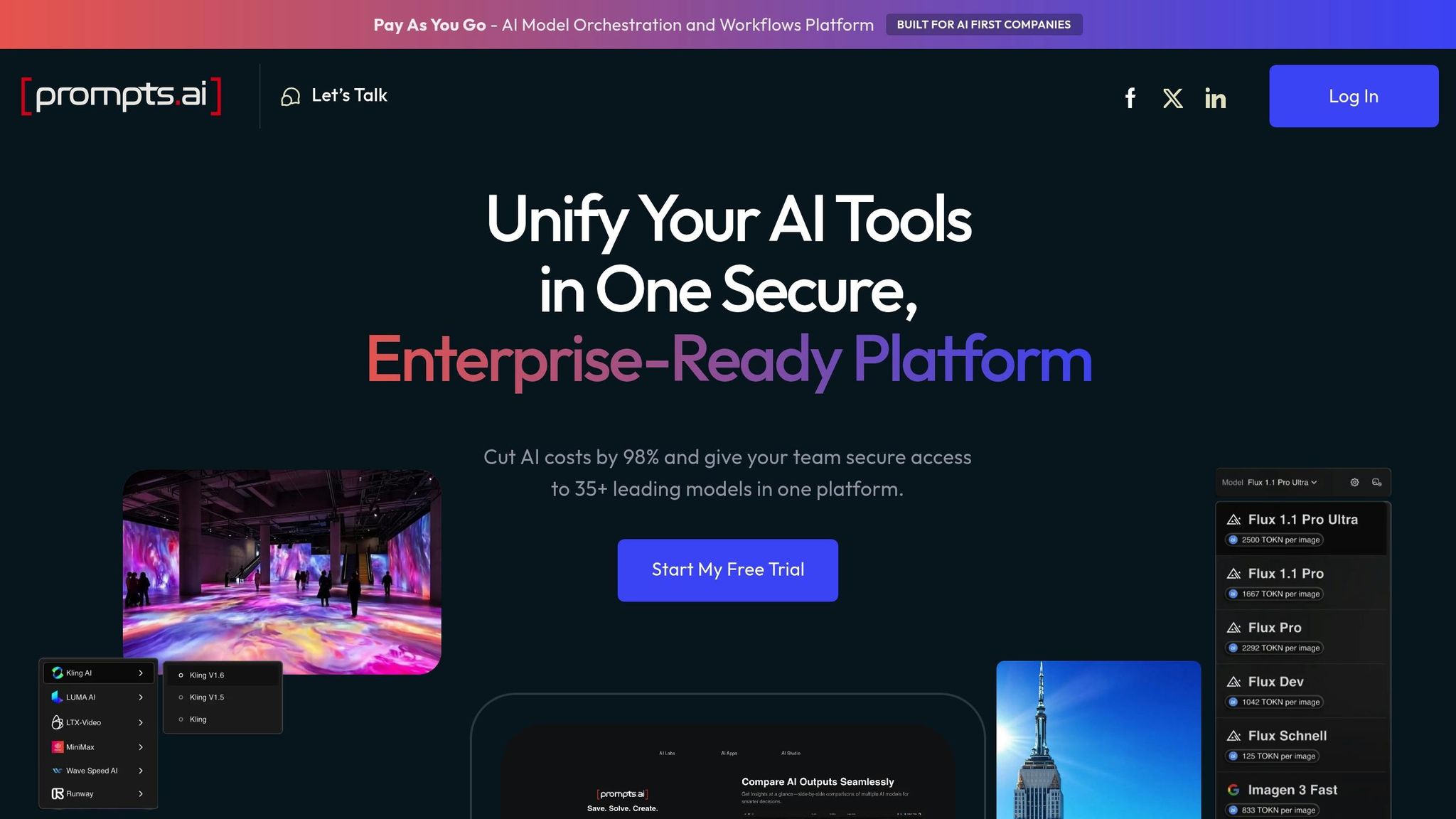
Prompts.ai is an enterprise-focused AI platform designed to streamline and simplify AI operations for organizations of all sizes. By bringing together over 35 top-tier large language models within a secure and unified interface, it caters to Fortune 500 companies, creative agencies, and research institutions. The platform addresses challenges like tool sprawl, ensures governance, and slashes AI costs by up to 98%. With its consolidated dashboard for model selection, prompt workflows, and cost management, Prompts.ai turns experimental AI initiatives into structured, compliant processes.
One of Prompts.ai's standout features is its extensive model support. It integrates models like GPT-5, Claude, LLaMA, Gemini, Flux Pro, Kling, and Grok-4, among others, enabling users to switch seamlessly between them and combine outputs within a single workflow. The platform also allows side-by-side performance comparisons, helping users identify the most effective models for specific tasks. Additionally, organizations can incorporate proprietary or fine-tuned models through custom endpoints, ensuring flexibility and tailored performance.
Prompts.ai places a strong emphasis on cost transparency and security, offering a FinOps layer to monitor token usage, optimize expenses, and link costs directly to outcomes. Its Pay-As-You-Go TOKN credit system eliminates the need for recurring subscription fees, aligning costs with actual usage.
Pricing Plans:
The platform also includes real-time dashboards and budget controls to prevent overspending, contributing to cost reductions of up to 98%.
Security is at the core of Prompts.ai’s design. The platform initiated its SOC 2 Type 2 audit process on June 19, 2025, showcasing its dedication to enterprise-grade standards. It adheres to industry frameworks like SOC 2 Type II, HIPAA, and GDPR to protect user data. Organizations can monitor their security status through the Trust Center (https://trust.prompts.ai), which provides access to policies, controls, and compliance updates. Continuous control monitoring, powered by Vanta, ensures ongoing oversight. Key features like full visibility, auditability, compliance monitoring, and governance tools are included across various pricing tiers.
Prompts.ai supports seamless integration with popular business tools through pre-built connectors for platforms like Slack, Google Workspace, and CRM systems. It also offers webhooks and REST APIs, enabling teams to trigger workflows based on external events and embed AI automation into existing business processes. These integration capabilities allow organizations to incorporate AI workflows into their current systems without significant disruptions, ensuring smooth and scalable operations.
With its cloud-native infrastructure, Prompts.ai is built to handle growing demands. The platform supports high-throughput workflows, auto-scaling, and performance monitoring to ensure reliable functionality as usage increases. Whether it’s adding new users, workflows, or models, teams can scale their operations in minutes, making it suitable for organizations of any size.
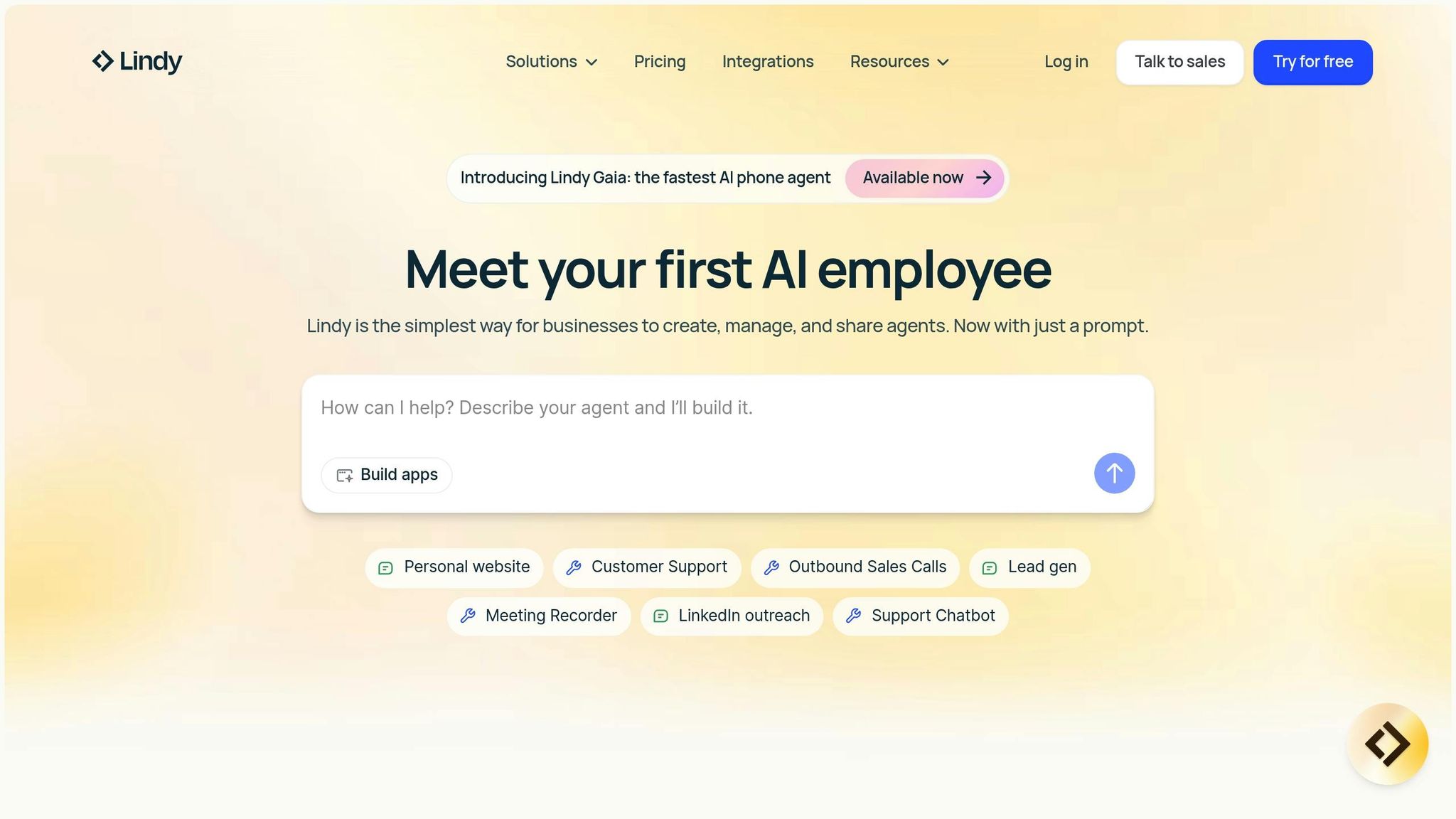
Lindy.ai is an AI automation platform designed with flexibility and adaptability in mind. By being model-agnostic, it allows users to choose from a variety of top AI models to power their agents, rather than being confined to a single provider's ecosystem. This open approach makes it ideal for organizations looking to combine different AI capabilities within a unified automation framework.
At its core, Lindy.ai excels in creating Multi-Agent Systems, where multiple AI agents collaborate to manage complex workflows. These agents can be activated by various triggers through multi-trigger workflows, enabling them to respond to multiple business scenarios simultaneously. This setup highlights the platform's focus on model interoperability and dynamic automation.
Lindy.ai's model-agnostic design lets businesses select the best AI models for specific tasks within their workflows. Whether optimizing for performance, cost, or a particular specialty, users can mix and match models to suit their needs. This flexibility ensures that workflows can evolve as new models emerge or as organizational requirements shift.
The platform also supports smooth transitions between different AI models within a single workflow. For example, one agent might rely on a model tailored for data analysis, while another uses a model designed for natural language generation - all within the same automated process. This ability to combine models enhances efficiency and precision across tasks.
Lindy.ai integrates seamlessly with a wide range of business applications and systems, offering hundreds of integrations to connect AI agents with existing workflows. Users can even link multiple accounts from the same provider, ensuring comprehensive coverage across platforms.
The platform can automatically update knowledge bases by pulling data from tools like Google Drive and Notion, ensuring that AI agents always work with the most current information. This continuous data refresh supports more accurate decision-making and task execution.
Other standout features include Autopilot, which allows agents to simulate human interactions with computers, and Looping, which lets agents process large data sets iteratively. Additionally, the platform's Conditions feature enables AI-driven logic within workflows, guiding agent actions based on specific criteria.
The Multi-Agent Systems architecture of Lindy.ai is built to scale effortlessly. Organizations can deploy additional specialized agents as their needs grow, ensuring that automation keeps pace with business demands.
With multi-trigger workflows, the platform adapts to increasingly complex organizational structures, responding to a growing number of events and conditions. AI agents can even be embedded directly into web pages, providing scalable customer-facing automation that evolves alongside business requirements.
The Looping functionality further supports scalability by enabling agents to handle larger volumes of data efficiently, making Lindy.ai an ideal choice for businesses managing rapid growth in data processing needs.
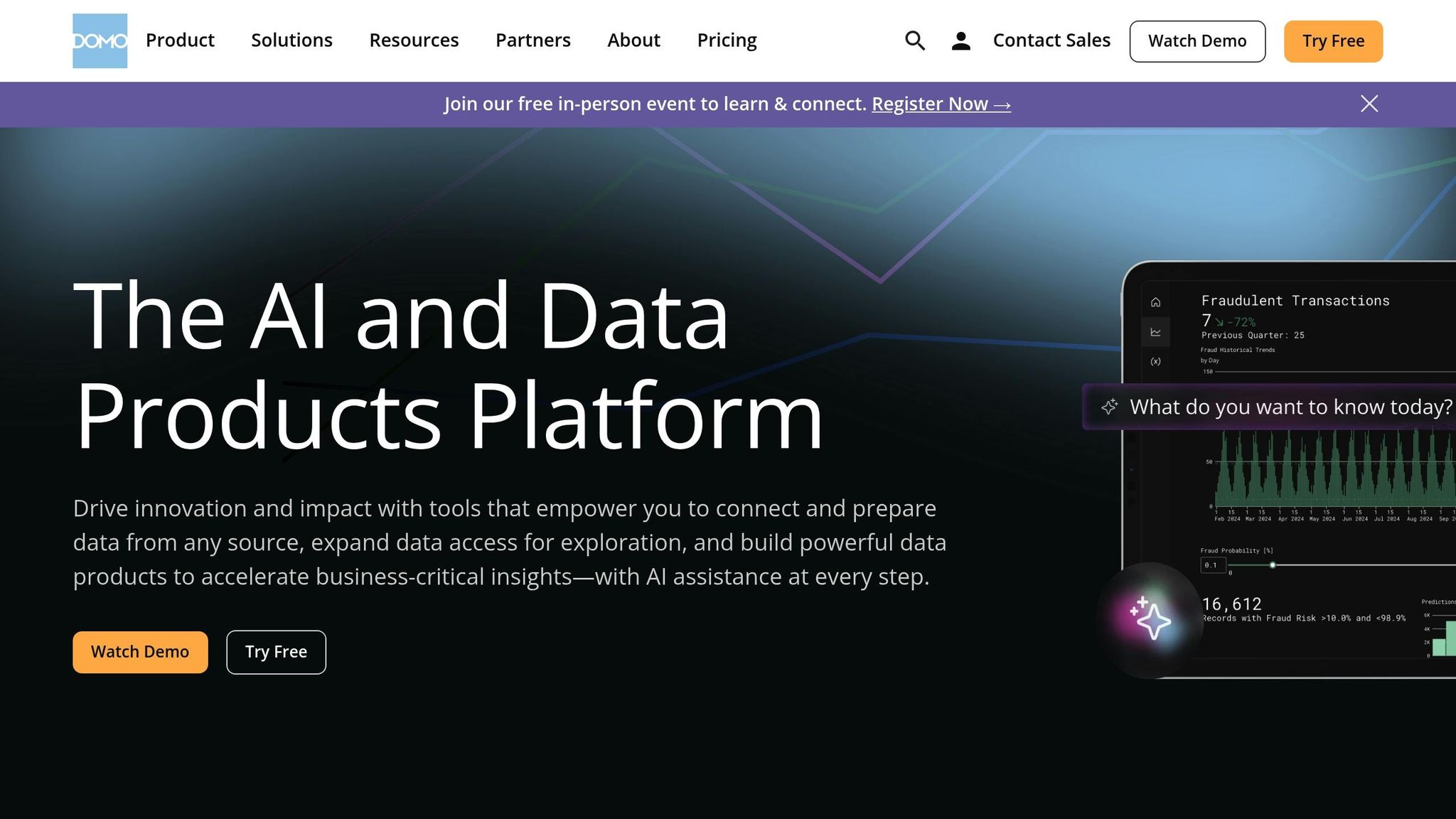
Domo is a cloud-native business intelligence platform that has evolved from a focus on data visualization to incorporating AI automation. This combination of traditional analytics with modern AI tools offers organizations a robust solution for managing data workflows. Here's how Domo handles integration, security, scalability, and cost management.
Domo stands out for its ability to connect seamlessly with key business tools, databases, and cloud platforms. It provides pre-built connectors for widely used systems like Salesforce, HubSpot, Google Analytics, and AWS, enabling businesses to consolidate data from multiple sources into their AI workflows.
The platform's Magic ETL tool simplifies data preparation through an intuitive, visual interface, making it easier to ready data for AI-driven tasks. For unique needs, Domo’s API-first design supports custom integrations, allowing organizations to create bespoke data pipelines and link proprietary systems. This flexibility ensures that businesses can adapt their workflows as their technology landscape changes.
Domo meets stringent compliance standards, including SOC 2 Type II, GDPR, and HIPAA, making it a reliable option for organizations with rigorous data protection requirements.
The platform employs role-based access controls that restrict data access within AI workflows to authorized users only. Permissions can be tailored down to specific datasets, dashboards, or automated processes, ensuring a high level of security throughout the data lifecycle.
Additionally, Domo offers detailed audit trails that log workflow activities, data access, and changes to the system. This transparency supports compliance efforts and provides accountability for all operations involving sensitive data.
Built as a cloud-native platform, Domo is designed to handle the demands of growing data volumes and increasingly complex workflows. Its architecture allows it to process large datasets efficiently, maintaining performance even as enterprises scale their AI automation efforts.
The platform uses elastic computing resources that adjust automatically based on workflow requirements. This ensures smooth operation during peak usage periods while keeping performance consistent. For organizations with diverse needs, Domo supports multi-tenant deployments, enabling different departments or teams to operate separate workflow environments while sharing the same infrastructure.
Domo uses a subscription-based pricing model, with tiers determined by the number of users and available features. Advanced AI workflow tools are included in higher-tier plans, providing businesses with predictable costs for their automation projects.
To help manage expenses, Domo offers usage-based billing for data processing, along with analytics that track data consumption across workflows. These insights allow organizations to optimize their spending.
The platform also includes resource monitoring tools that alert administrators to potential overages or unexpected costs. This proactive approach helps prevent budget overruns while ensuring workflows continue to perform effectively during critical operations.
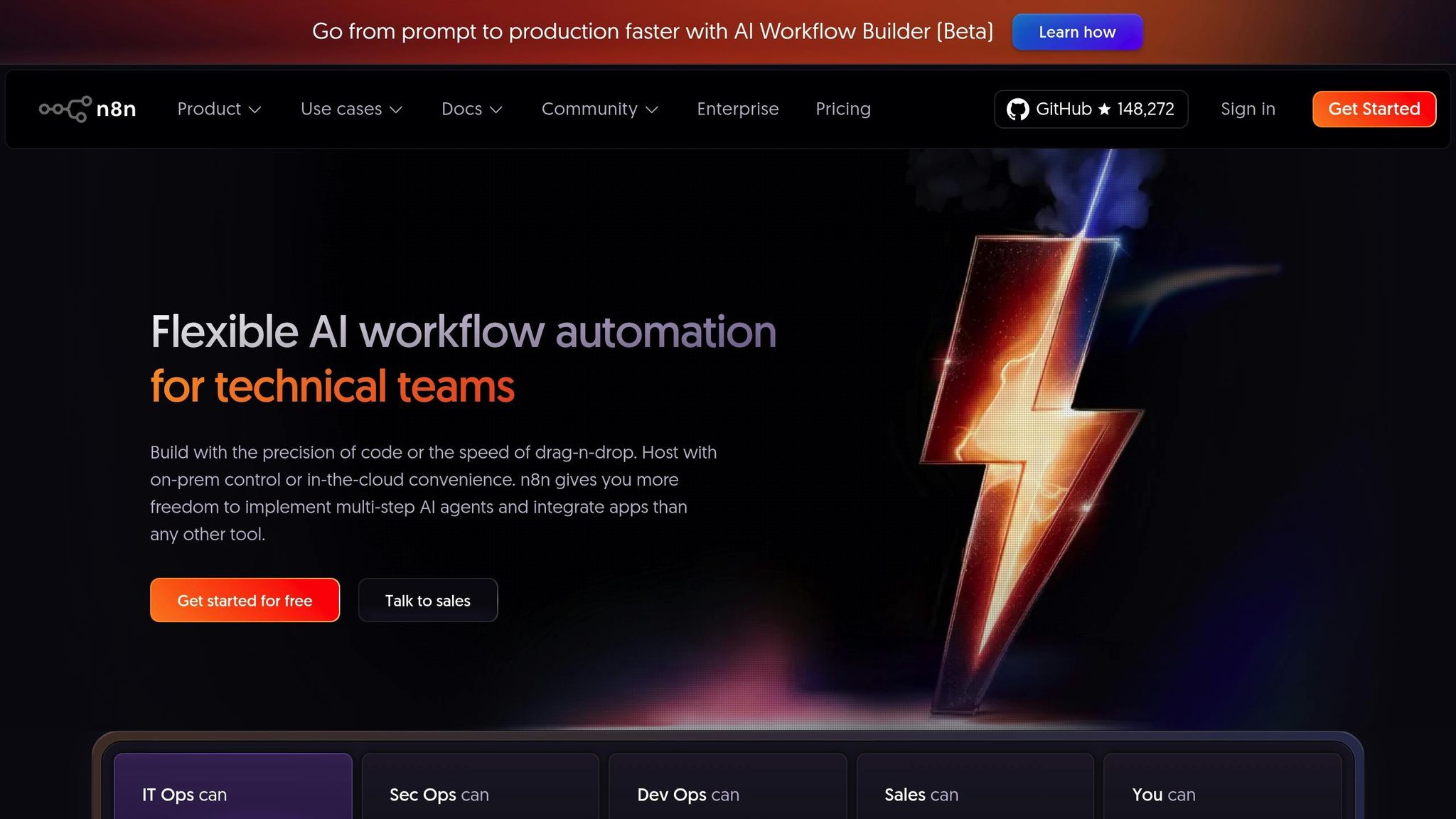
n8n stands out as a versatile, open-source platform widely trusted by technical teams for building AI workflows. With over 140,000 GitHub stars and a community exceeding 200,000 members, it has cemented its reputation as a reliable tool in the AI workflow space.
n8n’s flexible architecture makes it easy to connect a variety of AI models and services. It provides direct AI nodes for popular services like OpenAI and Google Gemini, while its universal HTTP Request node enables seamless integration with virtually any REST API-based model. This allows users to create workflows that incorporate branches, loops, and dynamic responses based on AI outputs. These features enable sophisticated orchestration, letting different models handle specialized tasks within broader workflows.
The platform also supports the Model Context Protocol (MCP), which standardizes interactions between large language models and external systems. For teams needing custom solutions, n8n allows the use of JavaScript or Python code, along with libraries from npm or Python repositories, to further extend its capabilities.
With over 400 integrations and 1,700 templates, n8n offers a robust toolkit to kickstart AI projects. It connects effortlessly to a wide array of data sources, vector databases, and MCP servers. The platform also supports "Human-in-the-Loop" processes, allowing users to embed approval steps and safety checks into their workflows. Additionally, its memory integration features, such as support for Retrieval Augmented Generation (RAG), enable the creation of AI agents capable of reasoning and maintaining context across multiple interactions. These integrations make it easier to deploy scalable and efficient AI solutions.
n8n is designed to handle both cloud-hosted and self-hosted environments, making it suitable for a range of deployment needs. Self-hosting is particularly beneficial for large-scale AI workloads, as the pricing is based on full workflow executions rather than individual tasks. For instance, in 2025, Delivery Hero saved 200 hours each month with a single ITOps workflow built using n8n. Similarly, StepStone reduced two weeks of work to just two hours, achieving a 25x improvement in speed.
"We have seen drastic efficiency improvements since we started using n8n for user management. It's incredibly powerful, but also simple to use."
- Dennis Zahrt, Director of Global IT Service Delivery
n8n’s pricing model focuses on full workflow executions, offering significant cost savings for complex AI automation. For example, processing 100,000 tasks on other platforms often exceeds $500 per month, while n8n’s pro plan starts at just $50. A 14-day free trial is available without requiring a credit card [10,11]. For organizations with high-volume needs, self-hosted deployments provide further cost optimization by tying expenses to server resources rather than usage metrics.
n8n prioritizes security and governance, allowing organizations to customize their implementations to meet specific needs. Its community has also contributed over 4,100 AI automation workflows, offering a rich library of proven templates for secure and efficient workflow management.
In 2025, SanctifAI - a leader in Human-AI collaboration - implemented its first n8n workflow in just two hours for a team of over 400 employees. This was three times faster than developing Python controls for LangChain.
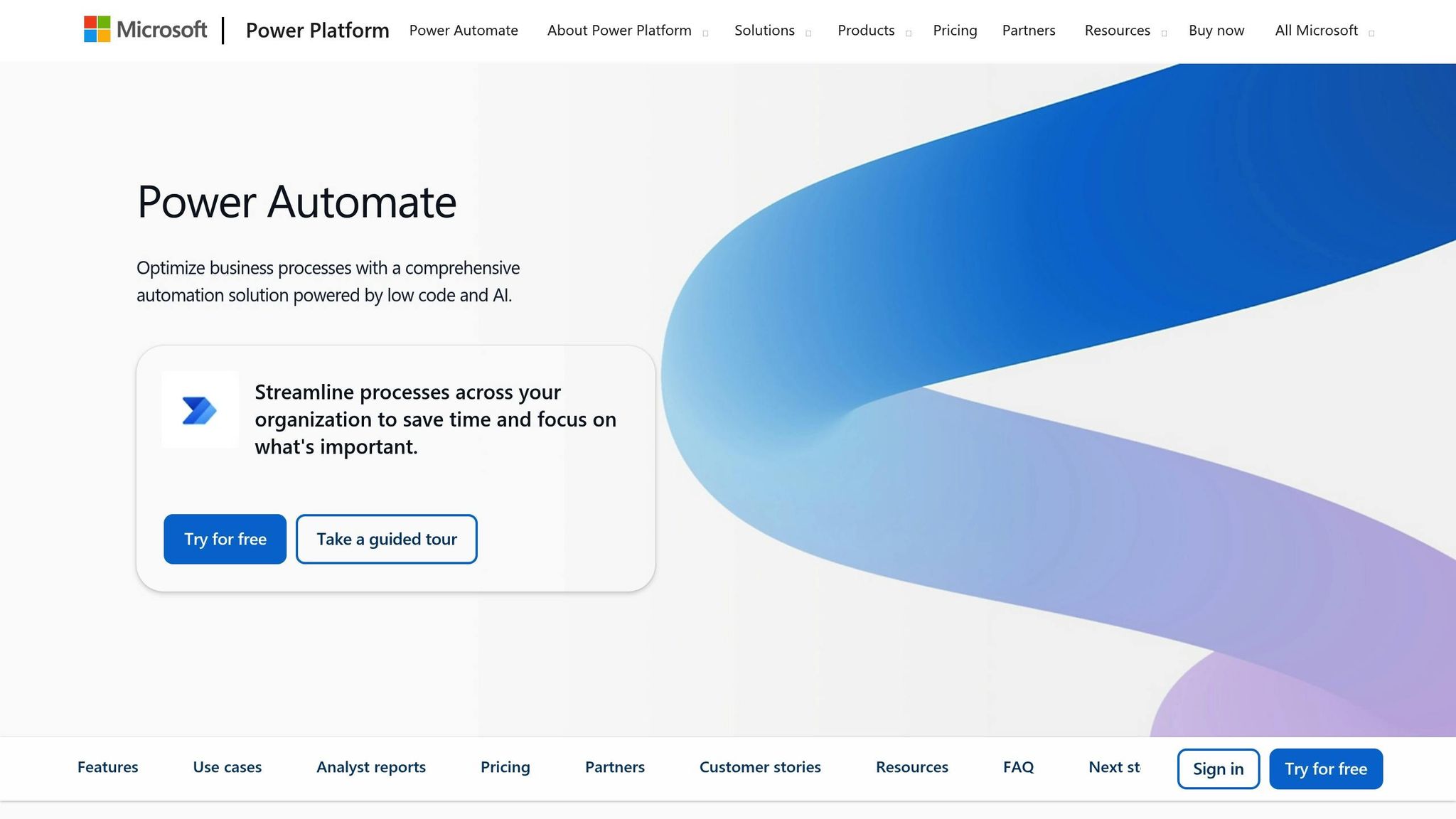
Microsoft Power Automate, part of the Microsoft Power Platform, simplifies business processes by enabling automation and AI-powered workflows.
Power Automate integrates effortlessly with Microsoft’s AI services, allowing users to incorporate features like natural language processing and image recognition into their workflows. With built-in connectors and customizable options, businesses can design automation solutions tailored to their specific needs. This compatibility strengthens its connection to essential business tools and enhances operational efficiency.
The platform provides a wide range of connectors for seamless integration with popular business tools, including Teams, SharePoint, and Excel. It supports both cloud-based and desktop-based automation, enabling businesses to modernize their processes while still accommodating older systems.
Built for enterprise use, Power Automate handles workflows of varying scales, from small to large volumes. It offers dedicated environments for development, testing, and production, making it adaptable to different stages of deployment and operational requirements.
With Azure Active Directory integration and data loss prevention measures, Power Automate prioritizes security. It also includes audit logging and compliance features, providing a solid framework for organizations to maintain governance over their automated and AI-driven workflows.
Power Automate includes tools to help manage costs effectively. Organizations can monitor usage, set spending alerts, and adjust their automation strategies as needed to align with budgetary goals, ensuring operational expenses remain under control.
Following the detailed platform reviews earlier, here's a streamlined comparison of their strengths and weaknesses to help you make an informed choice.
Each platform brings its own set of advantages and limitations. Knowing these differences allows you to align your selection with your specific needs and constraints.
Prompts.ai stands out for its cost efficiency and extensive model compatibility, offering access to over 35 leading language models through a single interface. Its pay-as-you-go TOKN credit system eliminates recurring subscription fees, cutting AI software costs by up to 98%. Additionally, enterprise-grade governance and built-in FinOps controls provide the transparency required by many organizations. However, businesses heavily reliant on traditional workflow automation tools may need extra integration efforts to fully utilize the platform.
Lindy.ai is praised for its simplicity and user-friendly design. Its predictable, usage-based pricing makes it an ideal option for companies without deep technical expertise. The platform minimizes the learning curve, but its focus on general use cases may fall short in delivering the advanced customization or enterprise-level security larger organizations often require.
Domo excels in scalability for enterprise-level data workflows, making it a strong choice for business intelligence and data processing teams. Its infrastructure handles large data volumes seamlessly, integrates well with existing enterprise systems, and offers extensive analytics capabilities. However, its custom pricing model can be a barrier for smaller organizations, and its complexity may not suit teams seeking simpler automation tools.
n8n strikes a balance between affordability and flexibility for technical teams. Its open-source nature allows complete control over infrastructure and data, with self-hosted options that eliminate subscription costs. Starting at just $20 per month for cloud plans, it’s accessible for growing businesses. While developers can create custom nodes and integrations, non-technical users may find the interface less intuitive.
Microsoft Power Automate offers seamless integration for organizations deeply embedded in the Microsoft ecosystem. Its connections with Teams, SharePoint, Excel, and other Microsoft services create a unified automation environment. Features like Azure Active Directory integration and compliance measures make it a secure choice for regulated industries. However, Microsoft’s complex licensing structure can make cost planning difficult, and businesses outside the Microsoft environment may gain limited value.
| Platform | Model Interoperability | Security | Pricing | Scalability |
|---|---|---|---|---|
| Prompts.ai | Excellent (35+ LLMs) | Enterprise-grade | Pay-as-you-go | High |
| Lindy.ai | Good | Standard | Usage-based | Medium-High |
| Domo | Limited | Enterprise-grade | Custom | Infinite |
| n8n | Good | Self-managed | $20/month+ | High |
| Power Automate | Microsoft-focused | Enterprise-grade | Complex licensing | High |
This overview highlights the trade-offs and provides guidance for selecting the right platform for your needs.
When evaluating platforms, consider how costs scale with usage. Pricing models based on per-seat or per-task fees can become expensive over time, while flat or usage-based pricing offers more predictable growth. For teams with strict data privacy requirements, open-source solutions like n8n provide cost control and full infrastructure oversight. Non-technical users might benefit from platforms with low-code builders and ready-made templates, though ensuring scalability is critical for long-term success.
Ultimately, your choice should reflect your team's technical expertise, current tool ecosystem, and future scalability goals. Choose the platform that integrates seamlessly with your workflows and supports your evolving AI initiatives.
Selecting the right AI workflow platform hinges on aligning its features with your operational priorities. Your choice should reflect your specific needs, technical expertise, and growth ambitions. Prompts.ai stands out by offering access to over 35 language models within a unified ecosystem, paired with a flexible pay-as-you-go TOKN credit system. This approach can reduce AI costs by up to 98%, all while ensuring enterprise-grade governance and clear financial oversight.
To make the most of these advantages, it's essential to integrate the platform's capabilities with your existing infrastructure and long-term goals. Evaluate factors like your team's technical proficiency, data privacy requirements, and budget limitations when planning for AI adoption. Opting for a solution with broad model compatibility and transparent pricing ensures you avoid vendor lock-in and unexpected expenses as your AI usage grows.
In a rapidly changing AI environment, prioritizing a platform that evolves alongside new technologies is key to securing enduring value. With the right alignment, you can transform AI's potential into measurable business outcomes.
When choosing an AI workflow platform, it's essential to focus on the features that align with your business priorities. Start with integration capabilities - the platform should work smoothly with the tools and systems you already rely on. Scalability is another key consideration, ensuring the platform can grow alongside your business needs. Don't overlook security features and user-friendliness, particularly if your team includes members with varying levels of technical expertise.
Platforms with low-code or no-code options can be a game-changer, making it easier to implement and reducing the need for specialized skills. Features like real-time data processing, automation orchestration, and governance tools are also worth prioritizing. These capabilities not only simplify workflows but also help maintain control and oversight. By focusing on these factors, you can select a platform that boosts efficiency and aligns with your organization's objectives.
Prompts.ai places a strong emphasis on security and compliance, utilizing industry-standard protocols and proven practices to protect sensitive data. The platform incorporates advanced encryption, stringent access controls, and conducts regular audits to ensure your information remains secure.
To further build trust, Prompts.ai adheres to critical regulatory frameworks, offering businesses across various sectors confidence in their AI-driven workflows. These efforts safeguard your operations while reinforcing reliability in managing complex processes.
A pay-as-you-go pricing approach offers adaptability and savings by charging users solely for the resources they consume. This setup is particularly advantageous for businesses with changing demands, as it allows them to adjust usage without being tied to fixed expenses.
For instance, this pricing structure can help lower operational costs by matching expenses to actual usage, making it ideal for startups, creative ventures, or organizations handling seasonal spikes in workload. It’s a smart way to avoid overspending on unused resources while still having access to advanced AI tools.


